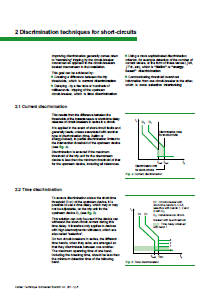Discrimination techniques
The purpose of this “Cahier Technique” is to set out the discrimination techniques which apply specifically to low voltage power circuit-breakers. These devices are characterized by their high rating (800 A to 6300 A), and their location at the head of the LV installation, generally directly downstream of an MV/LV transformer. This location justifies the strict discrimination requirements which apply to them.
This article begins with a resumé of discrimination techniques, followed by an explanation of the links between discrimination and general circuit-breaker characteristics. Finally, some practical examples will be provided on selection of devices to be installed.
Breaking capacity
This is the usual name for the ultimate breaking capacity (Icu). Icu is the highest short-circuit current intensity which the circuit-breaker is able to interrupt. It is defined for a given rated operating voltage Ue.
Cascading
Using the limiting capacity of the upstream circuit-breaker to increase the actual breaking capacity of the unit downstream. Enables use of circuit-breakers with a lower breaking capacity than the prospective short-circuit current downstream of a current-limiting circuit-breaker.
Current limiting circuit-breaker
Circuit-breaker which, when interrupting a short-circuit current, limits the current to a value considerably less than the prospective current.
DIN
“Déclencheur INstantané”: Instantaneous self-protection release. By assimilation, the corresponding threshold.
DINF (or MCR)
“Déclencheur INstantané à la Fermeture” or “Making Current Release”, instantaneous release intended for self-protection of the breaker during the closing operation.
Electrodynamic withstand (EDW)
Capacity of a unit to tolerate, by nature of its construction, the electrodynamic effects of a short-circuit current, in particular without repulsion of its main or plug-in contacts.
Isc
Short-circuit current, given as a peak value, actually crossing the circuit-breaker, taking account of any limitation.
Icw
Short-time withstand current. This is the maximum short-circuit current (as an rms value), which the circuit-breaker can withstand for a defined period (0.5 or 1 or 3 s) without alteration of its characteristics.
AUTHOR: Schneider Electric expert | Jean-Pierre NEREAU
| Title: | Discrimination with LV power circuit-breakers |
| Format: | |
| Size: | 0.25MB |
| Pages: | 30 |
| Download: | Right here | Video Courses | Membership | Download Updates |


